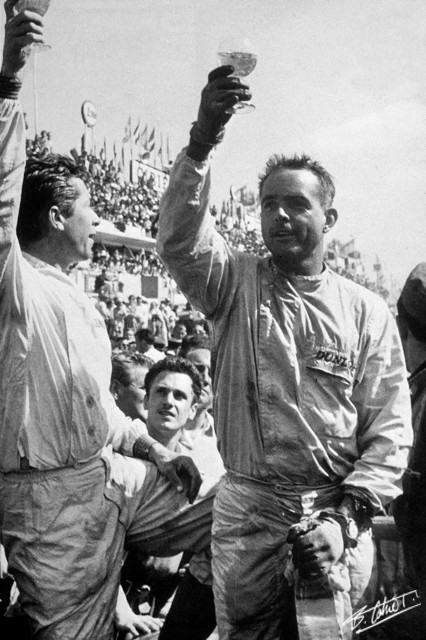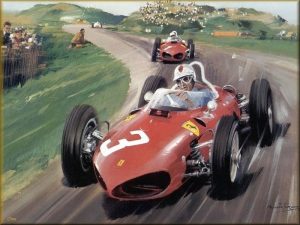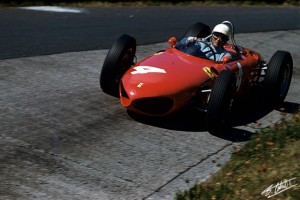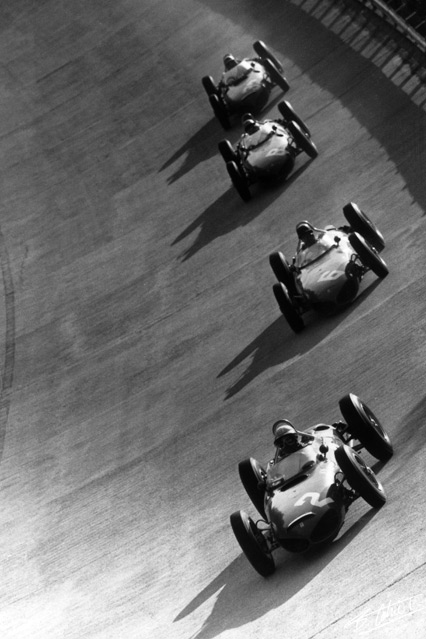Italian Grand Prix 1961-2011: Monza, Death of von Trips & A Yankee Champion
When we started the 2011 Formula One season back in March, I noted that 2011 is the 50th anniversary of the magical 1961 F1 season in which Phil Hill, driving for Ferrari, became the first, and other than Mario Andretti in 1978, only American Formula One Grand Prix World Champion. From our season opening post in March, Circus Starts Anew, 50 Years On From the Yankee Champion:
As starts the 2011 Formula One season, so too started the 1961 F1 season fifty years ago. For all the differences brought by technology and time over five decades, there is much in common. The excitement and anticipation of the drivers, the longing to put the knowledge of the off season testing and tech changes finally to proof in actual race conditions, the first drivers’ meetings of the season, the beautiful people and the eyes of the international sporting world focused. There is nothing like the Formula One circus; that was the case then as much as it is now.
Longtime regulars here at the Emptywheel Trash Talk threads will likely remember that I had the privilege of knowing Phil Hill as I was growing up. Phil was the first, and still one of only two (Mario Andretti), Americans to win the Formula One Grand Prix World Championship and his career was immortalized in the excellent biography Yankee Champion by William Nolan. 2011 is the fiftieth anniversary of his championship season. In honor of that, I will be comparing and remembering the races and excitement of the 1961 season over the course of the current season. See here for some simply superb [Cahier Archive] photos from the 1961 season.
Phil was my friend, and my mentor. I miss him.
This will be the last formal installment in the 1961 retrospective series. While there are 19 races in this year’s 2011 F1 schedule, with six remaining after the Italian, there were only eight races on the 1961 docket. The Italian was the seventh and penultimate race, and the one that will not only live in infamy, but in which the Championship was determined. Indeed, with both the Driver’s and Constructor’s Championships decided at Monza in the Italian, and in light of the tragic death of their star factory driver, Count Wolfgang von Trips, the dominant Ferrari team did not even travel the Atlantic to contest the final race, the inaugral United States Grand Prix at Watkins Glen, NY.So, in 1961 all the marbles came down to the famed steep banked course at Autodromo Nazionale Monza, north of Milan in Italy. Brad Spurgeon has a wonderful setting piece in yesterday’s New York Times:
Not many towns give the impression of being built around a racing circuit like Monza and the Autodromo Nazionale di Monza. Then again, Monza also happens to be one of the most historic racing tracks in the world, and, sitting as it does in a royal park, it has a national monument feel to it as well.
History is everywhere at Monza, which has been hosting the Italian Grand Prix since the 1920s. The old, banked oval track is still visible near the circuit used today. The 5.7-kilometer, or 3.5-mile, circuit has four long straights where speeds can reach 340 kph or more.
“Monza features the highest straight-line speeds of the year at around 350 kph, the highest average lap speed and, at 83 percent, the highest percentage of the lap spent at full throttle — not for nothing is it known as a ‘temple of speed,”’ said Norbert Haug, vice president of Mercedes-Benz Motorsport.
Read the rest of Brad’s article to also get a fuller flavor of the actual locale, separate from the track itself.
As to the track, however, suffice it to say that, hands down, Monza is the fastest in F1. In 1961, unlike the shorter and safer current 4.3 mile configuration, Monza featured a 6.2 mile circuit featuring a siamesed set of steeply banked 180 degree curves, with up to a 45 degree slope. One of the the stories I remember most vividly Phil telling from his F1 days was of the incredible speeds and physical forces on the driver at Monza. Phil had a brilliant mind, was highly detailed in his descriptions of things and often extremely demonstrative physically while doing so. Which made for a memorable depiction of Monza, to say the least. When he would describe how going through the high banking put such forces on the suspension that it caused the bottom of the car to basically travel on the paved surface, and regularly meet the surface with attendant sparks and grinding, you could literally almost feel, with him, the intense heat on your seat and danger of mistake. That, and the flat out speed, made Monza a dangerous enterprise indeed. The photo to the right, by the incomparable F1 photographer Bernard Cahier, is of a Monza bank in 1961, with Phil Hill leading his fellow Ferraris of Richie Ginther, Ricardo Rodriguez and Giancarlo Baghetti.So, that was the setting and, yes, it was truly 50 years ago to the day, as the 1961 Italian GP was run on September 10, 1961. The video up top, while certainly not perfect, gives a very complete rundown of where the season stood prior to the race, who the key contestants were, and what the grid looked like at the start of the race. The actual race coverage is fine, even if a little thin; still, very much worth watching.
The race immediately prior to Monza was the German Grand Prix at Nurburgring (the Bernard Cahier photo above is of Phil in the 1961 German GP), which was won by Stirling Moss in the underpowered, but well handling and superbly driven Lotus-Climax. After the German, and despite Sir Stirling’s win, the Driver’s Championship was still a battle between Ferrari teammates Hill and von Trips, with Trips leading in points with 33, Phil in second with 29 and Moss a distant third with 21 points. From F1 Fanatic:
Hill had won at Monza 12 months earlier, while von Trips suffered crashes in two previous visits to the circuit. Five years earlier his [von Trips] steering had broken at Curva Grande, sending him into the trees at 190kph (120mph). Two years after that he crashed into Harry Schell’s BRM on the first lap.
The championship protagonists were two decidedly different characters. Von Trips, a German Count, was a natural talent but one with a slightly wild streak in his early years that led him to be dubbed ‘von Krash’. Later his rivals referred to him more affectionately as ‘Taffy’.
Hill was more technical in his approach and had great mechanical sensitivity. Earlier that year he won the Le Mans 24 Hours for the second of three times in his career.
Hill was also acutely aware of the dangers of motor racing. It weighed heavily on his mind, and at times caused him to develop stomach ulcers from the stress, which disrupted his racing season in 1954.
So began the 1961 Italian Grand Prix at Monza. The start was smooth, with the Ferraris taking the lead, but by the second lap, things had grown more competitive and dicing among the drivers was well underway. During the fateful second lap, untold tragedy struck. Again, from F1 Fanatic:
At Parabolica Gerry Ashmore’s Lotus spun off and hit the grass bank along the track and the driver was badly injured.
A trio of Ferraris led the field as they came off the Curva Sud Alta Velocita for the first time to complete lap one, Hill ahead of Ginther and Rodriguez. Clark lay fourth with Jack Brabham, von Trips and Baghetti behind him.
Halfway around the second lap, Clark had fallen behind von Trips and was trying to re-pass the Ferrari as they sprinted from Vialone to Parabolica.
“I was preparing to overtake him and my front wheels were almost level with his back wheel as he started to brake,” Clark described afterwards.
“Suddenly he began to pull over towards me and he ran right into the side of me. I honestly don’t think Taffy realised I was there. I am sure that, when he passed me earlier, he had decided his was the faster car and I would be left behind.”
Clark was on the left-hand side of the track as von Trips moved across. The contact fired the Ferrari left towards the crowd.
It rode up a 1.5m-high bank and flipped over. With only a chain fence between the spectators and the track, there was precious little to separate car from bodies.
The car gouged into the crowd before flipping back onto its wheels on the track. Following cars braked hard and ducked around the wrecked Ferrari.
Von Trips was thrown from his car and killed, 11 spectators died at the scene, and four others succumbed to their injuries over the following days.
The rest of the race was, well, relatively speaking, uneventful. Phil crossed the finish line in first place, his second year in a row victorious at Ferrari’s home track of Monza, and with the win, and Trips disqualification, won the Driver’s Championship and, correspondingly, the Constructor’s Championship for Ferrari. The final race classification had American Dan Gurney second in a Porsche, followed by Bruce Mclaren and Jackie Lewis, both in Cooper-Climaxes.
 And thus, effectively, ended the 1961 Championship season (remember Ferrari did not, under the circumstances, even compete in the final race at Watkins Glen).
And thus, effectively, ended the 1961 Championship season (remember Ferrari did not, under the circumstances, even compete in the final race at Watkins Glen).
Phil Hill, the Yankee Champion, was crowned while both the drivers, teams and world mourned the carnage wrought by the tragic accident involving two greats, Jim Clark of Lotus and Count Wolfgang von Trips of Ferrari, not to mention the 15 innocent spectators’ lives taken in the path.
It was both one of the most glorious, and most tragic, days in motorsport history.
The photo at right, again from Bernard Cahier, is of Phil, this one posted as a toast to his 1961 F1 Championship, even though the photo is actually from his Le Mans triumph in 1962.
A.J. Baime has a very nice retrospective in Thursday’s Wall Street Journal if you would like some excellent further reading on the 1961 Italian.
As a side note, there are significant parallels between the glory and tragedy of Phil Hill’s 1961 Championship with the other American F1 Championship season, 1978 with Mario Andretti. As with Phil and Trips, Mario’s Championship run was marred by the death of his Lotus teammate, and closest points competitor, the great, and oh so fast, Ronnie Peterson. I had a chance to chat up Mr. Peterson briefly at the 1978 Long Beach Grand Prix; he was an immensely personable and jovial character, especially compared to the often stoic Swedes lately found in F1. Peterson, as with von Trips, died in flames at Monza. Again, as with von Trips, Peterson also, despite his death, still finished second in points, behind his eventual Championship teammate, in this case Andretti.
 Well, in the immortal words of the Allman Brothers, that was then and this is now. And now we are at the 2011 Italian Grand Prix, at the once and future home of F1 speed, Monza. In Friday’s Practice, the Red Bulls, Ferraris and McLarens were all fast under hot conditions. Saturday’s Qualifying was uneventful and went mostly as you would predict from the recent few races. Red Bull’s Sebastian Vettel took pole, his 10th of the year, followed by Lewis Hamilton and Jenson Button in the McLarens in P2 and P3 respectively, and Ferrari’s Fernando Alonso in P4.
Well, in the immortal words of the Allman Brothers, that was then and this is now. And now we are at the 2011 Italian Grand Prix, at the once and future home of F1 speed, Monza. In Friday’s Practice, the Red Bulls, Ferraris and McLarens were all fast under hot conditions. Saturday’s Qualifying was uneventful and went mostly as you would predict from the recent few races. Red Bull’s Sebastian Vettel took pole, his 10th of the year, followed by Lewis Hamilton and Jenson Button in the McLarens in P2 and P3 respectively, and Ferrari’s Fernando Alonso in P4.
With his win last time out at Spa, it is nigh impossible that anyone will overtake Vettel for the Driver’s Crown, and completely impossible to keep Red Bull from repeating its Constructor’s title. The warm weather looks to hold for the race, which should make for fast laps and increased tire wear, and that has been a pronounced variable this year with the new Pirelli tires. This is probably Sebastian Vettel’s race to lose in the Red Bull, and I would look to him for the win. In spite of Lewis Hamilton’s resurgence in the McLaren in the second half of the season, I would keep an eye on Alonso. Monza is, after all, the home of the Scuderia Ferrari. The Italian Red will be out in full force, and Fernando is still, when he wants to be, as fast a driver as there is in the Circus. Monza is a course of skill and speed, it should be a great race.
So, there is the Italian Grand Prix, both then and now. I would like to personally thank Paul-Henri Cahier of the Cahier Archive. The stills in this post are all from the Cahier Archive, taken by Paul-Henri’s father and partner, Bernard. I personally contacted Paul-Henri and asked for permission to use the same, which he generously granted. If you are a F1 and international motorsport fan, you can literally die and go to heaven in the Cahier Archive. Collectively, the Cahiers have been covering F1 and top flite motor racing for going on 60 years, and continue to this very day. Please give them a look, they are friends to us here, and if you see something you like, and if a racing fan, you will, please support and buy their work.
[As an added bonus, and thanks to Nomolos for reminding me in an offhand way, I have added in a video clip from John Frankenheimer’s 1966 classic movie Grand Prix that is the Monza footage from the movie. Frankenheimer was, until he died, a friend of Phil’s. Additionally, Phil served as a technical consultant on the movie and did much of the driving of the camera car actually doing the filming for the movie.]
[As a second update bonus, I want to add in a couple of pieces from the Road & Track Special for the 50th Anniversary of Phil Hill’s 1961 Championship Season. I wrote most of the main post from memory as well as notes and articles I have had around for quite some time, except for a couple of things like the Brad Spurgeon piece on Monza. Unfortunately, that caused me to miss two absolutely fantastic pieces in Road & Track. Spectacularly good pieces, both by very good friends of Phil’s, R & T writer and photographer extraordinaire John Lamm and the other by Sam Posey. John’s is a wonderful race by race trip, as related by Phil, through the 1961 season. Phil Hill: 50 Years Later – The 1961 Formula 1 championship year in Phil Hill’s own words. Great work and, independently, John is one heck of a nice man and a star or his own right. Posey’s, (who I do not know much, but have always appreciated) is entitled A Man Like No Other is more of a biography as painted by Sam, and it too is really fantastic.]

